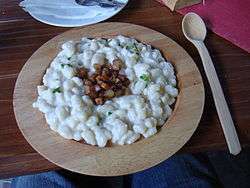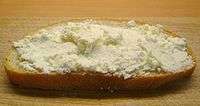Bryndza
Bryndza (from Romanian brânză - cheese) is a Slovak product of a sheep milk cheese made mainly in Slovakia, but also in Romania, Moldova, Poland, Russia, Ukraine, Serbia, Hungary and part of Moravia (Moravian Wallachia) in Czech Republic.[1] Bryndza cheese is creamy white in appearance, known for its characteristic strong smell and taste. The cheese is white, tangy, crumbly and slightly moist. It has characteristic odor and flavor with a notable taste of butyric acid. The overall flavor sensation begins slightly mild, then goes strong and finally fades to a salty finish. Recipes differ slightly across countries.

| Look up bryndza in Wiktionary, the free dictionary. |
| Bryndza | |
|---|---|
 | |
| Country of origin | Romania, Slovakia, Poland, Ukraine |
| Region | Central and Eastern Europe[1] |
| Source of milk | Sheep |
| Pasteurized | No |
| Texture | Depends on variety |
| Fat content | Depends on variety |
| Certification | Bryndza Podhalańska: PDO[2] Slovenská bryndza: PGI[3] |
Etymology
Known as juhtúró in Hungarian, брынза in Russian, brenca in Serbian, Brimsen in German, and ברינזע in Yiddish,[4] bryndza, a word borrowed from Romanian brânză ("cheese"), is used in various countries throughout Ukraine and the EU,[5] due to its introduction by migrating Vlachs. Though the word brânză (Romanian pronunciation: [ˈbrɨnzə]) is simply the generic word for "cheese" in Romanian,[6] there is no special type of cheese associated with it. It is a word presumably inherited by the Romanian language from Dacian,[7][8] the language of the pre-Roman population in modern-day Romania. Outside Slovakia and the flanking regions of Southern Poland, it is still popular nowadays in the Czech Republic under the Czech spelling "brynza".
History
The word was first recorded as brençe, described as "Vlach cheese", in the Croatian port of Dubrovnik in 1370. Bryndza was first recorded in Kingdom of Hungary, in 1470 and in the adjacent Polish Podhale in 1527.[9] In Slovakia, bryndza serves as the main ingredient to bryndzové halušky, which is regarded the national speciality (halušky - small gnocchi - are mixed with bryndza and topped with fried chops of fatty bacon). Bryndza is therefore regarded as typically Slovak product. The modern version of the soft spreadable bryndza is believed to have been developed by entrepreneurs from Stará Turá (Western Slovakia) toward the end of the 18th century who founded bryndza manufactures in mountainous regions of Central and Northern Slovakia where sheep cheese production had deep roots in the local cheese manufacturing tradition, and traded with it, popularizing bryndza all around the Austrian Habsburg Monarchy. In Austria, it was called Liptauer, after the northern Slovak Liptov region. The Viennese speciality Liptauer, a savoury cheese-based spread, has replaced bryndza with common cows' milk cottage cheese because the original Slovak bryndza disappeared from Austrian market after the disintegration of Austro-Hungarian monarchy.
Geographical indications
- Slovenská bryndza from Slovakia has been registered in the EU's Register of protected designations of origin and protected geographical indications on 16 July 2008[3] as a Protected Geographical Indication (PGI). The geographical indication was requested on 4 October 2007.[10]
- Liptovská or ovčia bryndza is another variety for Slovakia which contains 100% sheep cheese [11]
- Bryndza Podhalańska from Poland has been registered in the EU's Register of protected designations of origin and protected geographical indications on 11 June 2007[2] as a Protected Designation of Origin (PDO). The geographical indication was requested on 23 September 2006.[12]
See also
- Brânză de burduf from Romania, made from caș
- Austrian Liptauer
- Bulgarian Sirene
- Greek Feta
- Italian Ricotta
- Mexican Queso fresco
- List of cheeses
References
- "Cheese Description: Bryndza". Cheese.com. Retrieved 2008-06-11.
- European Commission (2007-06-11). "Commission Regulation (EC) No 642/2007 of 11 June 2007 registering a name in the Register of protected designations of origin and protected geographical indications Bryndza Podhalańska (PDO)". Retrieved 2008-06-10.
- European Commission (2008-07-16). "Commission Regulation (EC) No 676/2008 of 16 July 2008 registering certain names in the Register of protected designations of origin and protected geographical indications". Retrieved 2008-07-23.
- "Rumania, Rumania!". Yiddish Songs and Lyrics.
- Vasmer, Max; Oleg Trubachyov (1996). "бры́нза". Этимологический словарь русского языка (Etymological dictionary of the Russian language) (in Russian) (3rd ed.). ISBN 5-7684-0023-0. Retrieved 2008-07-22.
- "cheese". Dictionar Englez Roman - English Romanian Dictionary Online. Industrial Soft. Archived from the original on 2008-07-08. Retrieved 2008-07-09.
brânză
- Ion I. Russu, Limba traco-dacilor, Editura Ştiințifică, 1967
- Ariton Vraciu, Limba daco-geților, Timişoara: Editura Facla, 1980
- Votruba, Martin. "Bryndza". Retrieved 2008-12-07.
- European Commission (2007-10-04). "Publication of an application pursuant to Article 6(2) of Council Regulation (EC) No 510/2006 on the protection of geographical indications and designations of origin for agricultural products and foodstuffs (2007/C 232/10)". Retrieved 2010-08-30.
- "Bryndza - Cheese.com". www.cheese.com. Retrieved 2018-03-21.
- European Commission (2006-09-23). "Publication of an application pursuant to Article 6(2) of Council Regulation (EC) No 510/2006 on the protection of geographical indications and designations of origin for agricultural products and foodstuffs". Retrieved 2008-06-10.
Further reading
- Ehlers, S.; Hurt, J. (2008). The Complete Idiot's Guide to Cheeses of the World. Complete Idiot's Guide to. Alpha Books. p. 117. ISBN 978-1-59257-714-9. Retrieved May 19, 2016.